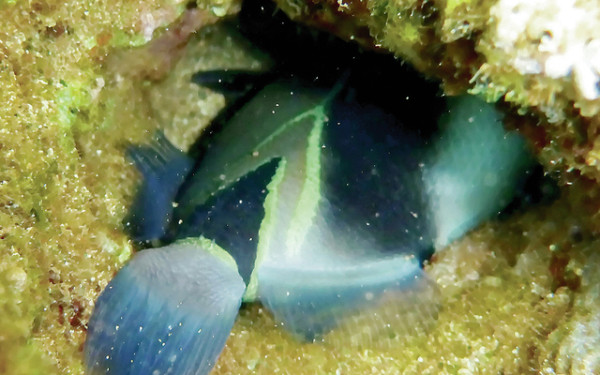Published in the Ocean Watch column, Honolulu Star-Advertiser © Susan Scott
April 18, 2016
Because it seems that wedgetail triggerfish are having a banner year, last week I swam in a straight line and counted them. In only a few minutes, I saw 12.
I know I wasn’t counting the same fish over and over because I was snorkeling in 4 to 5 feet of water, and my close passing caused each fish to dive into a bunker. And there they stayed, locked and loaded. Once a triggerfish is in a hole, it really is locked.
 The wedgetail triggerfish can brace itself inside a hole in the reef,
The wedgetail triggerfish can brace itself inside a hole in the reef,
safe from predators, using spines. One species,
the humu-humunukunukuapuaa, is the official state fish.
©2016 Susan Scott
Triggerfish prefer spaces so small the fish can barely squeeze their bodies inside. Tough, sandpapery skin allows triggerfish to scrape against coral rock without harm.
Once in, the fish raises from its back a long hard spine that sticks into the cave’s ceiling. A smaller spine behind fits into a groove of the larger, bracing it upright. To anchor its lower half, the triggerfish extends a bone on its belly. It’s the fish version of jamming a chair under a doorknob.
Triggerfish wedge themselves in so securely that one could pull the fish out only by reaching in and depressing the second, bracing spine.
But don’t try it. Triggerfish are also loaded. Their weapons are sharp chisel-like teeth, eight in an outer row and six more in an inner row that shore up the outer.
Nor should a snorkeler or diver try getting a close look at a triggerfish’s egg mass. The mother will charge, and sometimes bite, anything threatening her clutch.
In other fish families that lay eggs on the ocean floor, such as damselfish and blennies, males guard the eggs. But triggerfish males have harems, which leaves them little time for baby-sitting. The male patrols his territory of females, chasing away interloping males with mating on their minds. That leaves each female in the harem responsible for safeguarding her own brood.
All this chasing and charging is exhausting for both sexes, but triggerfish romance is a one-day affair. Females lay their eggs at dawn, the male immediately fertilizes them and their tiny offspring hatch that night.
Of the world’s 37 species of triggerfish, all ranging throughout the Pacific and Indian oceans, Hawaii hosts 10. One, however, is special here because of a 1984 election for Hawaii’s state fish. The multihued wedgetail triggerfish won, partly because it has a cute Hawaiian name in a cute Hawaii song. In “My Little Grass Shack” the humuhumunukunukuapuaa go swimming by. With all their darting and ducking, wedgetail triggerfish remind me of kids playing soldiers while wrapped in their grandma’s patchwork quilts. Whatever the cause of this fish bloom right now, I’m glad of it. Dozens of humuhumunukunukuapuaa brighten any day.